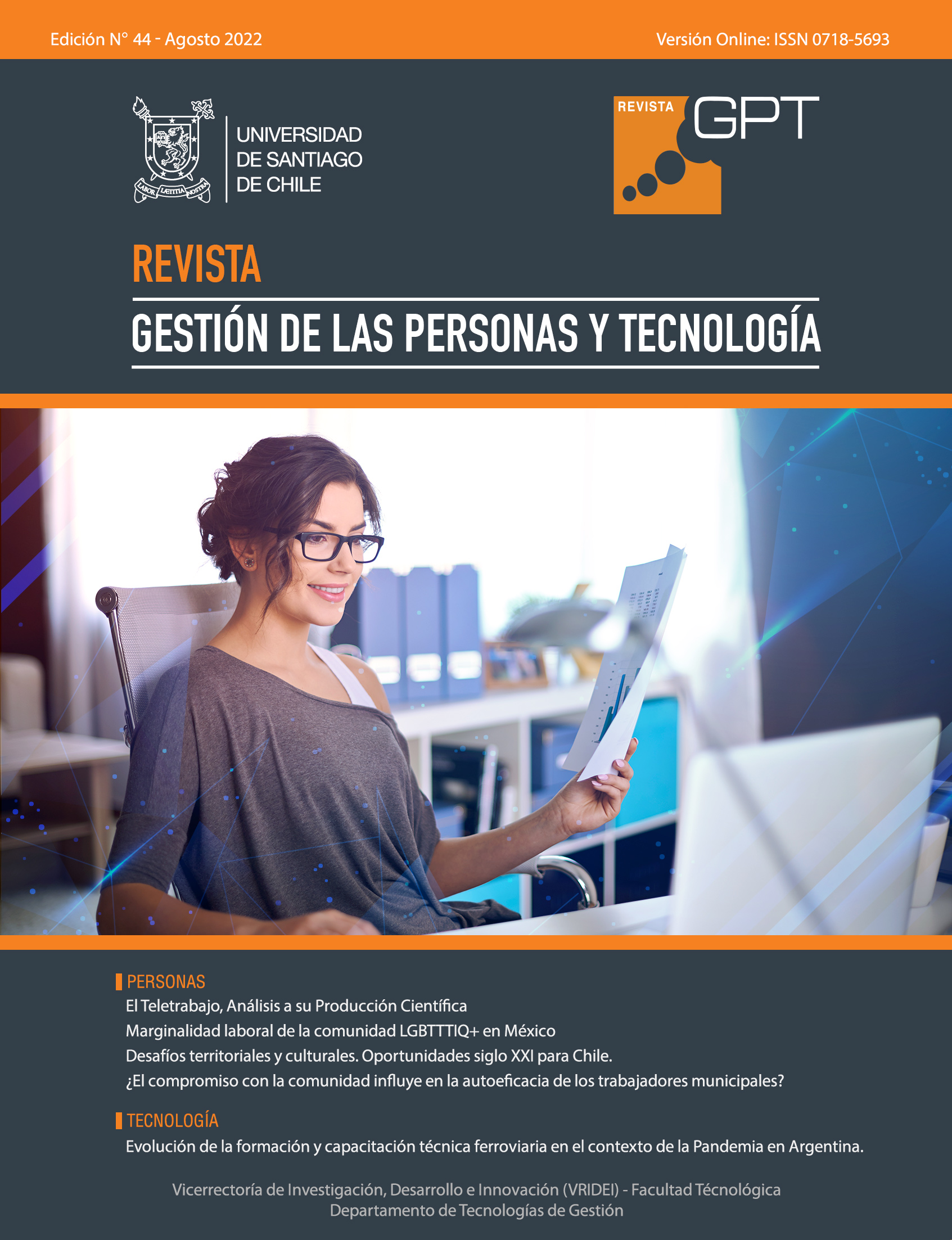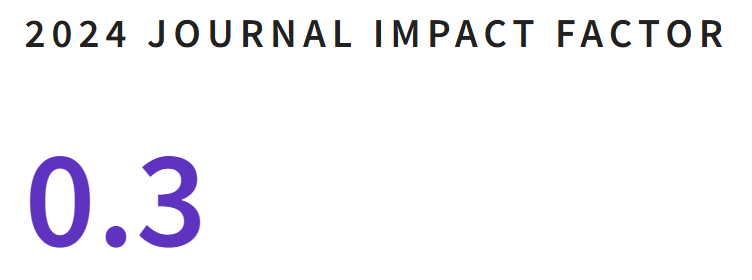Teleworking a Bibliometric Analysis of its Scientific Production
DOI:
https://doi.org/10.35588/gpt.v15i44.5639Keywords:
Telework, bibliometrics, scientific productionAbstract
The article aims to present the development of the existing scientific literature on teleworking and identify whether Covid-19 has had an impact on scientific production in the Scopus and Web of Science databases. The methodology used to develop this research is based on a bibliometric study between the period from 1977 to October 29, 2020, in which a total of 1667 documents were reviewed through the Bibliometrix and VOSviewer software, including articles, book chapters and books. The analysis that was performed on the documents was at the level of authors, sources, documents, and keywords through the number of documents, citations, H-index, Bradford's law, Lotka, in addition to co-citation and co-authorship networks. Ultimately, scientific production has increased little by little over the years, however, Covid-19 caused this production to increase considerably. Most of the documents written on the subject are produced in collaboration and originate mostly in the United States and the United Kingdom, with Latin American countries lagging far behind in the production of teleworking documents.
Downloads
References
Agudo Moreno, M. (2014). El teletrabajo en las organizaciones: análisis de sus beneficios y barreras en las empresas españolas. Cuadernos de Gestión de Información, 4(0), 172–187. https://doi.org/10.1016/j.estger.2014.07.001
Aguirre, J. (2015). Strategic intelligence: A system to manage innovation. Estudios Gerenciales, 31(134), 100–110. https://doi.org/10.1016/j.estger.2014.07.001
Andalia, R. C., Labrada, R. R., y Castells, M. M. (2010). Scopus: The largest database of peer-reviewed scientific literature available to underdeveloped countries. Acimed, 21(3), 270–282.
Araujo, C. A. (2006). The principle of least effort and Zipf distribution. Em Questão, 1113(1), 11–32. https://doi.org/10.1088/1742-6596/1113/1/012007
Araújo, J. y Arencibia, R. (2002). Informetría, bibliometría y cienciometría: aspectos teórico-prácticos. ACIMED, 10(4), 5-6.
Ardanuy, J., y Rey Vázquez, L. (2009). Breve introducción a la bibliometría. Universitat de Barcelona, 63. https://doi.org/10.1038/nmat3485
Aria, M., y Cuccurullo, C. (2017). bibliometrix: An R-tool for comprehensive science mapping analysis. Journal of Informetrics, 11(4), 959–975. https://doi.org/10.1016/j.joi.2017.08.007
Bailey, D. E., y Kurland, N. B. (2002). A review of telework research: Findings, new directions, and lessons for the study of modern work. Journal of Organizational Behavior, 23(SPEC. ISS.), 383–400. https://doi.org/10.1002/job.144
Barba, L. (2001). El teletrabajo y los profesionales de la informacion. Teleworking and information professionals. Profesional de La Informacion, 10(4), 4–13. http://search.proquest.com/docview/57492624?accountid=17252%5Cnhttp://217.13.120.161:9004/uc3m?url_ver=Z39.88-2004&rft_val_fmt=info:ofi/fmt:kev:mtx:journal&genre=article&sid=ProQ:ProQ:lisashell&atitle=El+teletrabajo+y+los+profesionales+de+la+informacion.+
Baruch, Y. (2000). Teleworking: Benefits and pitfalls as perceived by professionals and managers. New Technology, Work and Employment, 15(1), 34-49.
Baruch, Y. y Nicholson, N. (1997). Home, sweet work: Requirements for effective home working. Journal of General Management, 23(2), 15-30.
Buira, J. (2012). El teletrabajo: entre el mito y la realidad. España: Editorial UOC
Cámara-Arilla, C. (2000). El teletrabajo, un indicador de cambio en el mercado de trabajo. Cuadernos de Relaciones Laborales, 17, 227–227. https://doi.org/10.5209/CRLA.33616
Carmona, V. C., Martens, C. D. P., Leão, A. L. D. B. C., Nassif, V. M. J., y Freitas, H. M. R. de. (2018). Empreendedorismo social: uma perspectiva bibliométrica na área de administração e negócios. Estudios Gerenciales, 34(149), 399–410. https://doi.org/10.18046/j.estger.2018.149.2912
Cascio, W. F. (2000). Managing a virtual workplace. The Academy of Management Executive, 14(3), 81–90. https://www.researchgate.net/publication/246755382_Managing_A_Virtual_Workplace
Chen, H., Chiang, R. H. y Storey, V. C. (2020). Business intelligence and analytics: from big data to big impact. MIS Quarterly, 36(4), 1165-1188.
Codina, P. L. (2005). Scopus: el mayor navegador científico de la web. El Profesional de La Informacion, 14(1), 44–49. https://doi.org/10.3145/epi.2005.feb.07
Contreras, O. E. y Rozo Rojas, I. R. (2015). Teletrabajo y sostenibilidad empresarial. Una reflexión desde la gerencia del talento humano en Colombia. Suma de Negocios, 6(13), 74–83. https://doi.org/10.1016/j.sumneg.2015.08.006
Da Silva, J. A. (2014). Flexibilidad y teletrabajo: Un studio bibliométrico sobre la producción científica. Perspectivas Em Ciencia Da Informacao, 19(2), 159–173. https://doi.org/10.1590/1981-5344/1884
Daim, T. U., Rueda, G., Martin, H. y Gerdsri, P. (2006). Forecasting emerging technologies: Use of bibliometrics and patent analysis. Technological Forecasting and Social Change, 73(8), 981–1012. https://doi.org/10.1016/j.techfore.2006.04.004
Diego, J. y Villegas, V. (2013). Telework: a way of incorporating handicapped people into the world of work and his work risk management. Ces Derecho, 4, 29–45.
Van Eck, N. J., y Waltman, L. (2010). Encuesta de software: VOSviewer, un programainformático para la elaboración de mapas bibliométricos. Scientometrics, 84(2), 523-538. https://doi.org/10.1007/s11192-009-0146-3
Ferreiro, L. (1986). Bibliometria y Seudobibliometria.pdf. Boletin de La Anabad.
Gómez, C. R. y Solana, V. H. (2005). La producción científica latinoamericana y la ciencia mundial: una revisión bibliográfica (1989-2003). Revista Interamericana de Bibliotecología, 28(1), 43–61. http://www.scielo.org.co/scielo.php?pid=S0120-09762005000100003&script=sci_arttext&tlng=es
Gupta, Y. P., Karimi, J. y Somers, T. M. (1995). Telecommuting: Problems Associated with Communications Technologies and Their Capabilities. IEEE Transactions on Engineering Management, 42(4), 305–318. https://doi.org/10.1109/17.482081
Halford, S. (2005). Hybrid workspace: Re-spatialisations of work, organisation and management. New Technology, Work and Employment, 20(1), 19–33. https://doi.org/10.1111/j.1468-005X.2005.00141.x
Havriluk, L. O. (2010). El Teletrabajo: Una opción en la era digital. Observatorio Laboral Revista Venezolana, 3(5), 93–109.
Hernández, R., Fernández, C., y Baptista, M. del P. (2010). Metodología de la investigación. http://www.casadellibro.com/libro-metodologia-de-la-investigacion-5-ed-incluye-cd-rom/9786071502919/1960006
Hirsch, J. E. (2005). An index to quantify an individual’s scientific research output. Proceedings of the National Academy of Sciences of the United States of America, 102(46), 16569–16572. https://doi.org/10.1073/pnas.0507655102
Hislop, D. y Axtell, C. (2007). The neglect of spatial mobility in contemporary studies of work: The case of telework. New Technology, Work and Employment, 22(1), 34–51. https://doi.org/10.1111/j.1468-005X.2007.00182.x
Hsieh, H. F. y Shannon, S. E. (2005). Three approaches to qualitative content analysis. Qualitative Health Research, 15(9), 1277–1288. https://doi.org/10.1177/1049732305276687
Izquierdo, G. (2000). El teletrabajo. Economistas, 384–388.
Jane, M., Jaramillo, M. y Jesús, M. (2009). El Análisis de redes en el estudio de la colaboración científica. Redes. Revista Hispana Para El Análisis de Redes Sociales, 17, 39–47.
Lopes, S., Costa, T., Fernández, F., Joao, M. y Farias, P. (2012). A Bibliometria e a Avaliação da Produção Científica: indicadores e ferramentas. 11° Congresso Nacional de Bibliotecários, Arquivistas e Documentalistas - Integração, Acesso e Valor Social.
Martinez, R. (2012). El teletrabajo como tendencia del mercado laboral. RETOS, Revista de Ciencias de La Administración y Economía, 2(4), 144–155.
Mejía, R. (2007). http://www.redalyc.org/articulo.oa?id=33613102
Nilles, J. M. (1975). Telecommunications and organizational decentralization. IEEE Transactions On Communications. Com23(10), 1142–1147.
Nilles, J. M. (1994). Haciendo realidad el teletrabajo: una guía para telegestores y teletrabajadores. Van Nostrand Reinhold: Nueva York.
Norton, M. J. (2001). Introductory concepts in information science. Information Today, Inc.: New Jersey.
Pritchard, Alan. (1969). Statiscal bibliography or Bibliometrics. Journal of Documentation, 25(4), 348-369.
Pérez, M. P., Sánchez, A. M., y De Luis Carnicer, M. P. (2002). Benefits and barriers of telework: Perception differences of human resources managers according to company’s operations strategy. Technovation, 22(12), 775–783. https://doi.org/10.1016/S0166-4972(01)00069-4
Rodríguez, D. C. (2017). Legislación laboral para el teletrabajo. Revista de Derecho Principia Iuris, 14.
Rojas, A. (2019). Teletrabajo: Beneficios para el empleado y empleador. In Universidad Militar Nueva Granada, 8(5).
Rueda-Clausen Gómez, C. F., Villa-Roel Gutíerrez, C. y Rueda-Clausen Pinzón, C. E. (2005). Indicadores bibliométricos: origen, aplicación, contradicción y nuevas propuestas. MedUNAB, 8(1), 29–36.
Sanguineti Raymond, Wi. (2002). Teletrabajo y globalización: en busca de respuestas al desafío de la transnacionalización del empleo. 1–109. https://wilfredosanguineti.files.wordpress.com/2009/08/teletrabajo-y-globalizacion-final-informe.pdf
Schur, L. A., Ameri, M. y Kruse, D. (2020). Telework After COVID: A “Silver Lining” for Workers with Disabilities? Journal of Occupational Rehabilitation, 30(4), 521–536. https://doi.org/10.1007/s10926-020-09936-5
Sharma, B., Boet, S., Grantcharov, T., Shin, E., Barrowman, N. J. y Bould, M. D. (2013). The h-index outperforms other bibliometrics in the assessment of research performance in general surgery: A province-wide study. Surgery (United States), 153(4), 493–501. https://doi.org/10.1016/j.surg.2012.09.006
Sosa, S. y Verano, D. (2007). La participación de los trabajadores en la decisión de implantar el teletrabajo en la organización. Revista de Investigación, 15. https://dialnet.unirioja.es
Spinak, E. (1996). Diccionario Enciclopédico de Bibliometría, Cienciometría e Informetría. Caracas: UNESCO, 34-131.
Sullivan, C. (2003). What’s in a name? Definitions and conceptualisations of teleworking and homeworking. New Technology, Work and Employment, 18(3), 158–165. https://doi.org/10.1111/1468-005X.00118
Urbizagastegui Alvarado, R. (1996). Una revisión crítica de la Ley de Bradford. Investigación Bibliotecológica: Archivonomía, Bibliotecología e Información, 10(20), 16–26. https://doi.org/10.22201/iibi.0187358xp.1996.20.3835
Wuchty, S., Jones, B. y Uzzi, B. (2007). The Increasing Dominance of Teams in Production of Knowledge. Science, 316(5827), 1036-9. https://doi.org/10.1126/science.1136099










